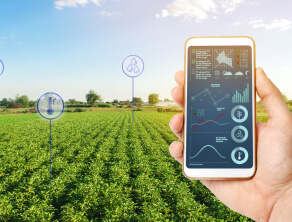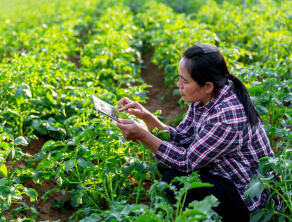Agriculture to Agritech: Trends, Challenges, and the Path Forward with Digital Technology and Software Solutions
Taking the Field:
Connected devices providing informed choices, artificial intelligence deep diving into farming data and providing guidance and corrective measures, simulated environments to better prepare farmers for incidents they might encounter in real life-none of these are fancy conjectures but elements of a revolution brought about by technology. This is the first of a series of articles where we cover the basics, look at projections and the overall state of disruption. Subsequent articles will cover specific technologies and the many ways in which they benefit agriculture.
Digital Transformation in Agriculture:
Before 2013 agri innovation tended to focus on biotech sector and plant genetics. It was in late 2013 that Agritech growth witnessed a shift in momentum. Investments in Agritech grew 75 percent to reach $860 million in 2013 and subsequently increased 170 percent in 2014. This strong growth in investment continued in 2015 and beyond. This momentum shift is attributed to a confluence of four underlying driving forces that are prevailing today:
Macroeconomic trends
Changing consumer preferences
Emerging technologies
Transforming value chains
1. Macroeconomics
A multitude of global megatrends such as urbanization, demographic changes, climate change, globalized trade, have collectively tipped the demand-supply balance in agriculture. It is estimated that agriculture industry would feed an estimated global population of 9.7 billion by 2050. In 2020 alone, a 60% increase is required to feed the population. Globally, the arable land per capita is nearing capacity which suggests that the paradigm of agricultural farming will have to shift. The increasing scarcity of water as a resource poses another threat. Water shortages have become a significant concern around the globe and, as per climate change projections, will only worsen over time. It has, therefore, become imperative that we find innovative methods to increase productivity, while also enhancing the efficiency of supply chains.
2. Changing consumer preferences
Changing consumer preferences have accelerated the need for new and innovative ways to meet agricultural demands. Consumers demand personalized products and solutions. They have become more health-conscious in food consumption and want their food to be traceable to validate and authenticate food origin and ensure that it has been grown right. Some consumers even demand sustainability and consume only organically grown food to reduce ecological footprint from their end. Further, the expectation to use services and products on demand has highlighted the need for an efficient supply chain that can cater to these demands while keeping the costs low.
3. Emerging technologies
The technological advancements in agriculture were earlier limited to applications of biological technologies, tissues, and organisms. With the advent of new technologies, we had access to manufacturing innovations for 3D printing and robotic work, autonomous vehicles that can perform tasks like fumigating plants, and devices and sensors that communicate with each other. But a lot more is needed to meet the rising demand for a paradigm shift in agriculture. Worldwide, the variety of advanced technologies such as IoT, machine learning, drones, blockchain and more are being leveraged to achieve maximum productivity and output with minimum input.
4. Transforming value chains
To reduce costs along the value chain, the agriculture industry is witnessing horizontal integration of related offerings into the agricultural ecosystem and vertical integration of input suppliers in an attempt to optimize cost, and increase efficiency.
Source: Agro Value Chain
Converting Challenges into Opportunities:
Due to these drivers of disruption, the agricultural ecosystem faces new challenges, from which three significant growth opportunities for existing and prospective innovators and players can be derived:
1. Improving yield efficiency
The world population is rapidly growing, thereby creating severe urgency to increase yields.
Reports suggest that yield improvement still has a potential of 30%. Investors can capitalize on this opportunity to feed the growing population.
2. Increasing supply chain efficiency
Value chain losses account for up to 33% losses in yield. To compensate for this, reducing the average value chain loss is a considerably more powerful way of increasing effective output than upfront yield improvement. As per statistics, to compensate 33% of value chain losses, a yield increase of 50% would be necessary whereas increasing supply chain efficiency by only 5% has the same effect on the output as a 10% yield improvement.
3. Decreasing complexity along farmers’ value chain
Tomorrow’s farmers need to deal with higher complexity and a rapidly growing amount of product and service offerings from different input providers along their value chain, it is inevitable that they will strive for simple, ease-to-use, complexity-reducing products, offered as integrated end-to-end solutions. This opens up another dimension of opportunities for innovators that intend to leverage the growing agritech sector.
Conclusion
In today’s challenging agriculture ecosystem, it is a given that leveraging digital solutions is the key. Digital technologies have made it possible to collect and utilize huge amounts of data efficiently, thus making a farm’s operations more insight-driven, and subsequently more productive and efficient. They not only have the potential to improve a farm’s business performance but can also meet the food demands of the growing population. The elimination of intermediaries from the supply chain and direct-to-consumer approach has disrupted traditional business models and also reduced yield loss. The digital disruption has created strong value zones into which new and existing agricultural players can tap with smart solutions to capture value and growth potential, considering the fact that digital agriculture still has considerable untapped potential.
Innovators can already be seen offering specialized services, often fully integrated solutions, ranging from direct delivery services through satellite imagery to automated farm management. In this environment, startups, agricultural players and cross-industry innovators can capitalize on the opportunities that come with the shift from agriculture to agritech.
Over the next few posts in this series, we will be going in-depth into specific technologies and their role in transforming agriculture. Stay tuned!
![Blog-[x]cube LABS](https://d6fiz9tmzg8gn.cloudfront.net/wp-content/uploads/2016/06/blog_banner.jpg)








